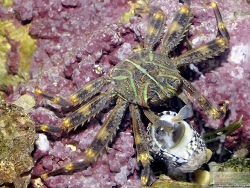Info
Percnon gibbesi (H. Milne Edwards, 1853)
Live in rock crevices at the top of the sublittoral, retreat extremely quickly to their hiding places, therefore very difficult to catch. Live intertidally, at depths of 0-10m. Up to 3 cm carapace width, total size up to 15 cm. Predominantly herbivorous, eating algae. Observations from aquaristics confirm the speed of these animals, they also gladly accept any food as well as carrion.
Percnon gibbesi is mainly classified as juvenile crab as herbivorous. As the crab grows larger it changes its feeding habit to carnivorous, of course it will continue to eat algae growth, but also others.
With most crabs, and so also with omnivorous percnon, what can still be captured is eaten, so to speak what is small enough that it "fits in the claws". So also small shrimps and / or small fish, if the possibility offers itself. What applies to the entire lifetime.
Percnon gibbesi is considered the most invasive crab in the Mediterranean. Where it appeared, it was able to establish populations at breakneck speed, both in human-influenced sites such as docks and in the wild, studies say.
Documented are the different distributions of the two species. Percnon gibbesi, for example, from the Pacific and Atlantic oceans along California to Chile and Florida to Brazil, respectively, as well as Africa from the Gulf of Guinea to the Azores, and as an invader across the Strait of Gibraltar in what is now almost the entire Mediterranean Sea. Animals on flat rocks sometimes showed colorations of aposematic mimesis (the imitation of species with warning colors).
Percnon planissimum is documented from Japan, the whole South Sea Islands in the Pacific, Hawaiii, the Indian Ocean up to Madagascar as well as Surinam (Atlantic!). The latter (Surinam) is probably a misidentification, because it contradicts all other data.
Illustrations, also scientific ones, show both species in both colorations. However, based on experience with imports and some sources, we assume that animals with the banded legs are Percnon gibbesi and with the yellow longitudinal stripes on the proximal limbs of the walking legs are Percnon planissimum. This is the only distinguishing feature that can be recognized without a detailed morphological examination even by laymen. Helpful is of course a place of origin.
Synonymised names
Acanthopus gibbesi H. Milne Edwards, 1853 · unaccepted > superseded combination
Lonchophorus anceps Eschscholtz, 1825 · unaccepted
Plagusia delaunayi de Rochebrune, 1883 · unaccepted > junior subjective synonym
Zoea boscii Guérin-Méneville in de la Sagra, 1857 · unaccepted > junior subjective synonym
Live in rock crevices at the top of the sublittoral, retreat extremely quickly to their hiding places, therefore very difficult to catch. Live intertidally, at depths of 0-10m. Up to 3 cm carapace width, total size up to 15 cm. Predominantly herbivorous, eating algae. Observations from aquaristics confirm the speed of these animals, they also gladly accept any food as well as carrion.
Percnon gibbesi is mainly classified as juvenile crab as herbivorous. As the crab grows larger it changes its feeding habit to carnivorous, of course it will continue to eat algae growth, but also others.
With most crabs, and so also with omnivorous percnon, what can still be captured is eaten, so to speak what is small enough that it "fits in the claws". So also small shrimps and / or small fish, if the possibility offers itself. What applies to the entire lifetime.
Percnon gibbesi is considered the most invasive crab in the Mediterranean. Where it appeared, it was able to establish populations at breakneck speed, both in human-influenced sites such as docks and in the wild, studies say.
Documented are the different distributions of the two species. Percnon gibbesi, for example, from the Pacific and Atlantic oceans along California to Chile and Florida to Brazil, respectively, as well as Africa from the Gulf of Guinea to the Azores, and as an invader across the Strait of Gibraltar in what is now almost the entire Mediterranean Sea. Animals on flat rocks sometimes showed colorations of aposematic mimesis (the imitation of species with warning colors).
Percnon planissimum is documented from Japan, the whole South Sea Islands in the Pacific, Hawaiii, the Indian Ocean up to Madagascar as well as Surinam (Atlantic!). The latter (Surinam) is probably a misidentification, because it contradicts all other data.
Illustrations, also scientific ones, show both species in both colorations. However, based on experience with imports and some sources, we assume that animals with the banded legs are Percnon gibbesi and with the yellow longitudinal stripes on the proximal limbs of the walking legs are Percnon planissimum. This is the only distinguishing feature that can be recognized without a detailed morphological examination even by laymen. Helpful is of course a place of origin.
Synonymised names
Acanthopus gibbesi H. Milne Edwards, 1853 · unaccepted > superseded combination
Lonchophorus anceps Eschscholtz, 1825 · unaccepted
Plagusia delaunayi de Rochebrune, 1883 · unaccepted > junior subjective synonym
Zoea boscii Guérin-Méneville in de la Sagra, 1857 · unaccepted > junior subjective synonym







 Pauline Walsh Jacobson, USA
Pauline Walsh Jacobson, USA




















